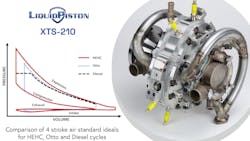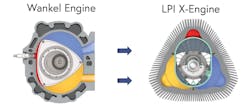This video appeared in Electronic Design and has been published here with permission.
Check out our AUVSI Xponential 2023 coverage.
LiquidPiston's new XTS-210 Engine is a rotary engine that employs a high-efficiency hybrid cycle (HEHC) (Fig. 1). It has high power density and specific power up to 5X that of more conventional diesel piston engines. It can operate using heavy fuels like diesel, Jet A, JP-8, and kerosene as well as gasoline, propane, and hydrogen. The system can be designed into hybrid electric systems as well. Alex Skolnik, co-founder and CEO, explains how the system works and its advantages (watch the video above). The current crop of engines deliver from four to 70 horsepower.
The X-Engine technology used in the XTS-210 is a direct drive rotary approach that can be viewed as an "inverted" Wankel engine. It has a trochoidal rotor with a three-lobed housing, but it utilizes a stationary combustion chamber that can employ a higher compression ratio to support direct fuel injection (Fig. 2).
The X-Engine has fewer moving parts (just the shaft and rotor) and utilizes stationary apex seals that provide direct lubrication and reduce blow-by effects. This also helps improve efficiency, emissions, and durability of the engine components.
The XTS-210 is a 25-hp, two-stroke, supercharged, liquid-cooled, 210 cc X-Engine variant that's almost 80% smaller and lighter than a convention diesel piston engine with similar performance characteristics. The supercharger adds up to one bar boost and delivers six combustion events per revolution. The higher number of events provides a smooth rotation.
This video shows how the engine works:
The engine can be used in a range of applications from a fixed, mobile electric power generator to drones and vertical take-off and landing (VTOL) aircraft.
Links
The video transcript below has been edited for clarity.
Hi, so we're with LiquidPiston. The company has developed advanced power solutions based on a new type of high-efficiency thermodynamic cycle and a new kind of rotary diesel combustion engine.
"So we've really kind of rethought the engine starting from the ground up. We went back to the physics of how engines operate with a thermodynamic cycle and what we're doing is trying to basically innovate in this space that's over 100 years old, right? It's a space that’s ripe for for for disruption. What we want to do is bring the efficiency of a very large diesel engine to the size and weight and package of something very small.
We're really pleased to announce a new XTS engine. It's our first time making a two-stroke variant of our X engine that operates on this new optimized thermodynamic cycle.
We focus on small engines today, below 100 horsepower, and they operate on heavy fuels like jet fuels, diesel fuel. We're primarily funded by the U.S. DOD. We're working with the government and it's primarily the Army and the Air Force on on this new engine technology. This is a concept of the XTS-210 engine. It's meant to be a 25-hp diesel engine.
It's meant for things like UAV applications and portable power-generation applications. So something like this would be great for powering, you know, like a genset for the military, for example. And if you look at the engines that this would displace, like a 25-hp diesel engine, would weigh 300 or 400 pounds. It would require something large to move around.
It's too big and heavy, logistically, for the military. This could be a real game-changer for things that fly and for mobile power generation. This is a conceptual mockup of the engine. We actually have this now built and running in the lab. We call this the XTS-210 engine. It's a 210 cc displacement two-stroke version supercharged variant of the X engine.
This engine has one bar of boost, and yeah, we have two versions of the engine. One is spark ignited. We're going to start with spark ignition. It's a lower compression ratio, but it can be developed for different kinds of fuel. And most of our development today is on jet fuel and diesel fuels. Moving forward, we can also adapt this for compression ignition with diesel fuels.
Some of your viewers might be familiar with the Wankel Rotary. This is a rotary engine. But unlike the prior Wankel Rotary, we sort of turned it inside out, right? You might remember the Wankel Rotary that has a triangular rotor inside of a kind of a peanut-shaped housing. We have the exact opposite here with a peanut-shaped rotor inside of a tri-lobed housing.
So take everything you might know about the Wankel Rotary and flip it inside out. Think about the Wankel, they have this long, skinny moving combustion chamber. It's probably the worst thing you can do for an engine. You have to get the fuel in and it has to mix and burn. And when the combustion initiates, you know, it kind of it's like a like a sphere, like a ball that's growing.
When it hits the wall, it extinguishes. So that's really not beneficial for for the engine. The Wankel Engine’s always kind of struggled with combustion. It also struggles with sealing, right? They have these apex seals and face seals. And it's really challenging to reduce blow-by in the engine. And also because these are moving parts, moving seals, how do you lubricate it?
What they end up doing is putting a lot of oil into the engine. That oil ends up burning and oil doesn't burn very well. And the seals are not lubricated well. So you end up with an emissions challenge and also a lubrication challenge. Basically, in sum, the Wankel Engine is great with having really good power to weight.
It's a very responsive engine because there's no oscillating mass. There's very few components in the engine, but it struggled with sealing, with cooling, lubrication, efficiency, emissions, durability, kind of everything you care about the engine doing. So it never really made it successfully, commercially. Turning the engine inside out, we solve all of these challenges, our apex seals, instead of moving in the chamber,
The apex seals are now stationary. And that means that they seal better, but also they can be lubricated directly from the housing. Tiny amounts of oil going directly to the seal surface, and that provides better lubrication, better durability. And then our combustion chamber, instead of that long, skinny moving chamber, we have a stationary combustion chamber located in the housing.
And what that means is we can drive up the compression ratio and it's suitable for direct injection of fuel. Those are the two ingredients that you need for a diesel cycle, right? High compression and direct injection. Our engine is the first rotary engine that's directly compatible with with a diesel cycle, a compression ignition cycle, which increases the efficiency.
In sum, it's a better take on the rotary engine with an upgraded thermodynamic cycle. We have different configurations of the engine and that's always been kind of a challenging part to understand. What we're introducing here to show, we're not fully open yet about how this one works. What you'll see on our website is an animation where the air comes in axially.
Air comes in either through the shaft into the rotor or it comes in through a side housing in the side plate. It then compresses, combusts, and expands and then it's exhausted out the other side of the engine, also axially. The new engine we have that we're working on is a two-stroke variant of the engine.
So the four-stroke for every revolution of the rotor, we get three combustion events each time the rotor spins around. It combusts in one of the three cavities. With the two-stroke, it now combusts on both sides of the rotor. As the rotor spins around, it combusts on both sides in all three cavities. We end up with six combustion events per revolution of the rotor.
The intake and exhaust is a bit of the secret sauce in this engine right now. We're not disclosing all the details of that yet. But we figured it out and it's working well in the lab."
Check out more of our AUVSI Xponential 2023 coverage.

